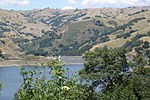Ed R. Levin County Park

Ed R. Levin County Park is the largest park in Milpitas, California. It is run by the Santa Clara County Parks and Recreation Department and is located in the chaparral and grassland foothills of Diablo Range east of the Santa Clara Valley. Monument Peak can be accessed through trails in the park. The park's recreational facilities include a hang gliding and paragliding area, a dog park, and horseback riding areas. Ed R. Levin County Park has two lakes, Sandy Wool Lake and Spring Valley Pond. Both of them are reservoirs which collect runoff water from the hills to the east. It is home to some of the East Bay Walls. The park is named after open space advocate and Santa Clara County 3rd District Supervisor Edgar R. Levin (1908-1965).
Excerpt from the Wikipedia article Ed R. Levin County Park (License: CC BY-SA 3.0, Authors, Images).Ed R. Levin County Park
Launchbase 2 Access Road,
Geographical coordinates (GPS) Address Nearby Places Show on map
Geographical coordinates (GPS)
| Latitude | Longitude |
|---|---|
| N 37.466604 ° | E -121.8569 ° |
Address
Launchbase 2 Access Road
Launchbase 2 Access Road
95035
California, United States
Open on Google Maps







